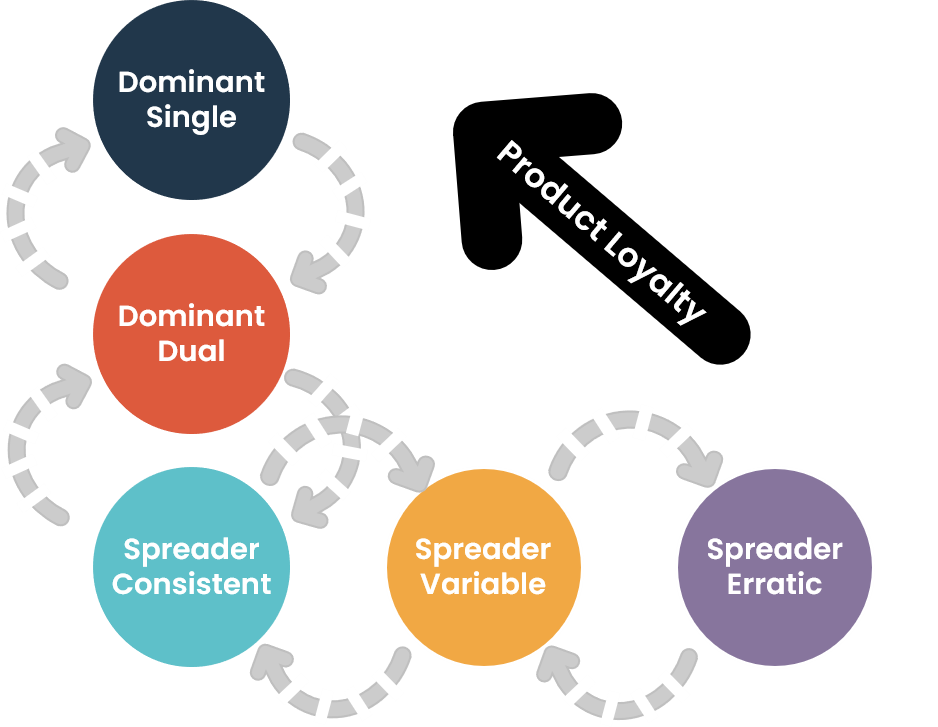Are Prescribers More Likely to Change Behavioral Segment or Product Loyalty?
Two critical elements that inform how biopharma sales representatives sell to HCPs are (1) the prescribing behavior exhibited by the HCP, or behavioral segment, and (2) the HCP’s loyalty to the products they prescribe. However, over the years, we have found that a prescriber’s loyalty to one of these two elements is stronger than the other, which, accordingly, has significant implications for how biopharma sales forces should sell to prescribers. In this blog post, we will investigate whether prescribers are more likely to switch behavioral segment than they are to switch the products they prescribe, and what the implications of this answer are in terms of selling strategy.
Five Segments of Prescribing Behavior
In order to answer whether behavioral segment is stronger than product loyalty, let’s first provide a brief overview of the concept of behavioral segments.
Prescribers demonstrate different types of behavior centered around five main types of prescribing action, what we refer to as behavioral segments:
Dominant Single
Prescriber is loyal to one product
Dominant Dual
Prescriber is loyal to two products
Spreader Consistent
Prescriber is loyal to several products, each with relatively consistent volume share
Spreader Variable
Prescriber is loyal to several products, each with inconsistent volume share
Spreader Erratic
Prescriber is inconsistent in products & amounts prescribed
Note that how these segments are defined varies depending on the number of products in the therapeutic class. For example, what might be considered a dominant dual behavior in a therapeutic class with seven products would not be considered a dominant dual behavior in a therapeutic class with four products. Additionally, a prescriber’s behavioral segment does not necessarily carry across therapeutic classes—just because a prescriber is a dominant single in blood pressure does not mean that the prescriber is also a dominant single in cholesterol.
Is Behavioral Segment or Product Loyalty Stronger?
To which of these two elements is a prescriber more loyal?
Over the years, we have found that prescribers are more likely to change product loyalty than they are behavioral segment. For example, prescribers classified as dominant single are more likely to change their dominant product than they are to change to a different behavioral segment.
When prescribers do change behavioral segment, we have seen that it is typically only to an adjacent segment as shown in the figure below. For example, a spreader consistent prescriber is more likely to become a dominant dual prescriber than a dominant single prescriber.
Thus, prescribers are more loyal to their behavioral segment than they are to the products they prescribe.
Implications for Selling Strategy
Knowing that prescribers are more likely to change product loyalty than they are to change behavioral segment provides invaluable insight into how to sell to that prescriber.
Consider a dominant single prescriber. If the dominant product is a competitive product, then it is more likely for a sales representative to switch the dominant product to your product than it is for the sales representative to convert a portion of the dominant product’s sales to your product (i.e., make the prescriber become a dominant dual prescriber). Oftentimes, getting such prescribers to switch product loyalty requires significant call activity, but if the sales representative is able to switch the dominant product to your product, then this means a considerable increase in sales as the prescriber is likely to remain a dominant single prescriber once switched to your product.
Thus, the loyalty of prescribers to their behavioral segment allows biopharma companies to focus on the behavioral segments with which there is the most opportunity to gain sales. Typically, these are prescribers in the dominant single, dominant dual, and spreader consistent behavioral segments who include your product in their loyalty mix; otherwise, a strategy to switch loyalty must be pursued, which is harder to achieve.
Conclusion
Both behavioral segment and product loyalty have significant implications for selling strategy and ensuring a sales call is as efficient and effective as possible. However, prescribers are actually more loyal to their behavioral segment than they are to the products they prescribe, providing insight into where the most opportunity for a sales force lies and how sales forces should sell to different prescribers. Request a free consultation with us today to get started on ensuring your prescribers are being classified into the proper segments and pursued with the proper selling strategy.







